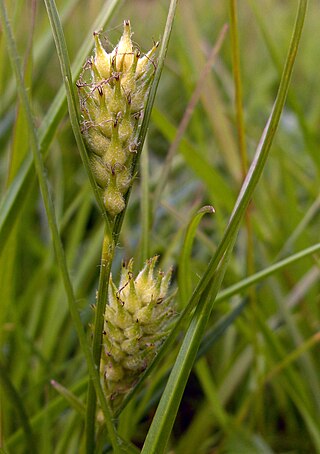
The Cyperaceae are a family of graminoid (grass-like), monocotyledonous flowering plants known as sedges. The family is large, with some 5,500 known species described in about 90 genera, the largest being the "true sedges" genus Carex with over 2,000 species.

Ornamental grasses are grasses grown as ornamental plants. Ornamental grasses are popular in many colder hardiness zones for their resilience to cold temperatures and aesthetic value throughout fall and winter seasons.

Carex is a vast genus of nearly 2,000 species of grass-like plants in the family Cyperaceae, commonly known as sedges. Other members of the family Cyperaceae are also called sedges, however those of genus Carex may be called true sedges, and it is the most species-rich genus in the family. The study of Carex is known as caricology.
Monanthocitrus oblanceolata is a species of flowering plant in the citrus family, Rutaceae. It is endemic to Sabah in Malaysia. It was first described in 1988.

Carex rostrata, the bottle sedge or beaked sedge, is a perennial species of sedge in the family Cyperaceae.
Stranvaesia oblanceolata is a species of flowering plant in the family Rosaceae.
Iphionopsis is a genus of African flowering plants in the daisy family.

Carex acutiformis, the lesser pond-sedge, is a species of sedge.

Drosera ultramafica is a species of sundew native to the highlands of Malesia. It is thought to be most closely related to Drosera spatulata, Drosera neocaledonica and Drosera oblanceolata. The taxon is readily distinguished from the former by its general habit and preference for mafic, upland habitats, and from the latter species by specific morphological differences, in addition to the fact that their geographical ranges do not overlap.

Carex riparia, the greater pond sedge, is a species of sedge found across Europe and Asia. It grows in a variety of wet habitats, and can be a dominant species in some swamps. It is Britain's largest Carex, growing up to 130 cm tall, with glaucous leaves up to 160 cm long. It hybridises with a number of other Carex species, including the closely related Carex acutiformis – the lesser pond sedge. A variegated cultivar is grown as an ornamental grass.

Carex hirta, the hairy sedge or hammer sedge, is a species of sedge native across Europe. It has characteristic hairy leaves and inflorescences, and is the type species of the genus Carex.

Carex pilulifera, the pill sedge, is a European species of sedge found in acid heaths, woods and grassland from Macaronesia to Scandinavia. It grows up to 30 cm (12 in) tall, with 2–4 female spikes and 1 male spike in an inflorescence. These stalks bend as the seeds ripen, and the seeds are collected and dispersed by ants of the species Myrmica ruginodis.

Carex sect. Ovales is a section of the genus Carex, containing around 85 species of sedge. It is the most diverse section of the genus in North America, containing 72 species:

Carex subg. Carex is a subgenus of the sedge genus Carex. It is the largest of the four traditionally recognised subgenera, containing around 1400 of the 2000 species in the genus. Its members are characterised by the presence of one or more exclusively male (staminate) terminal spikes, quite dissimilar in appearance from the lateral female (pistillate) spikes below. In most species, the female flowers have three stigmas, but a few species, including Carex nigra, have female flowers with only two stigmas.
Dalzielia is a genus of plants in the Apocynaceae first described as a genus in 1922. It contains only one known species, Dalzielia oblanceolata, native to tropical West Africa.

Carex subg. Vignea is a subgenus of the sedge genus Carex, containing around 300 of the 2000 species in the genus. Its members are characterised by having bisexual, sessile spikes, where the female flowers have two stigmas each.

Carex viridula, known as little green sedge, green sedge, or greenish sedge, is a small flowering plant native to North America, Europe, Asia, and Morocco.

Carex dioica, the dioecious sedge, is a species of flowering plant in the genus Carex, native to Iceland, the Faroes, Svalbard, nearly all of Europe, western Siberia, and the Altai. It prefers to live in calcareous fens.












